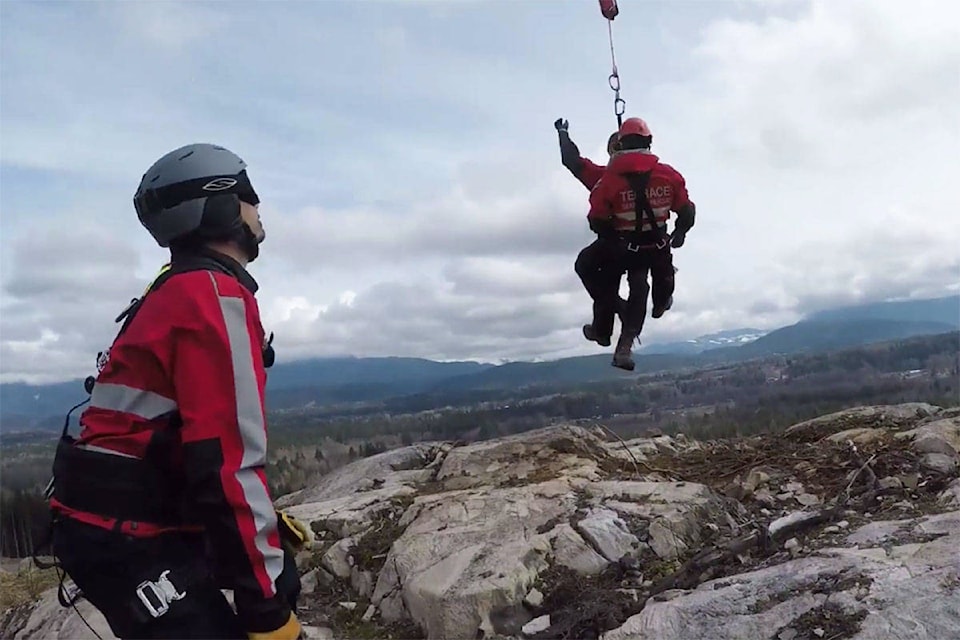In charge of covering a large response area in Northwest B.C., Terrace Search and Rescue (SAR) was faced with the possibility of being left without any provincial funding in last month’s budget.
The funding came in another way when the B.C. government announced $18.6 million for British Columbia Search and Rescue Association (BCSARA) on March 23, a week before the organization’s cash flow was set to dry up.
The one-time grant represents the largest provincial investment into SAR in the organization’s history, an increase from the $5 million given per year in supplemental funding. It will be used to support 80 ground search and rescue groups and 2,500 volunteers.
Dave Jephson, Terrace SAR vice-president, says this is the first time the province has committed to funding SAR groups past one-year. Based on previous allocations, he estimates the Terrace chapter will be getting approximately $80,000 a year for three years.
“Each year you didn’t know if you were getting it,” Jephson says. “Whatever the amount of money we have earmarked for each group, that group is going to know for the next three years they don’t have to worry about funds coming in.”
The announcement comes after pressure from BCSARA for the province to provide a stable, long term funding model for groups working throughout the province.
READ MORE: Concerns rise as B.C. search and rescue funding set to expire
“For many years our member groups have told us the difficulties they have applying for grants and fundraising, and the huge amount of time and resources these tasks take,” reads the BCSARA website.
Jephson says he knows all too well how much time and effort is needed just to find money for SAR.
“It is a brutal amount of time that search and rescue members give back to the purpose of trying to secure funds or raise money or run their organization. Brutal,” he says.
In 2018, TSAR committed 5,970 hours for training, operational task and community events. Jephson says members have already spent hundreds of hours trying to raise money for their new $1.3 million headquarters on Greig Ave.
“By having a secure model in place provided to our organizations from the province…enables our search and rescue members to focus on the real reason why they joined, and that is truly to help people and search for people in the wilderness.”
A spokesperson with Emergency Management BC says the money for SAR wasn’t budgeted for as a line item because the funding is presented as a one-time grant. There also needed to be discussions around what the funding model would look like year over year. The $18.6 million is coming out of the province’s General Capital.
Public Safety Minister Mike Farnworth has told BCSARA the province is committed to moving to a sustainable funding model before the end of the three-year grant. Farnworth says EMBC has also earmarked funding for two staff positions to work with BCSARA to develop and implement it.
Jephson says public outcry also helped put pressure on the province.
“When it was identified that there was a lack of funds in the budget, people started questioning it. Our executives through BC SARA, our teams started saying, ‘Hey, where’s our money?’” he says.
“If we have 2,500 people in the province donating their time to buy equipment, do training, be away from their homes for the citizens of the province, should there not be a steady funding model?”
READ MORE: Terrace SAR, military coordinate joint late-night backcountry rescue
Implementation of this core funding is key for the future, Jephson says, especially as industrial development picks up in Northwest B.C.
“Search and Rescue is expecting our call volume to skyrocket due to the introduction of tens of thousands of new employees coming in to work on projects,” Jephson says.
Terrace SAR had a large response area just within the last year. They had two mutual aid calls in Smithers, two mutual aid calls in the Dease Lake area, provided assistance to Kitimat and Prince Rupert, and were involved in two searches where they had to travel 2,320 kilometres.
“We have gone and gotten individuals out of all the mines in the North, we have gone to industry, we have gone to the tops of mountains to the bottoms of lakes to get people in our region. We know and we’re trying to prepare and plan for that increase in growth.”
A sustainable funding model could also mean a source of revenue for Terrace SAR to pull from to purchase necessary training and operational equipment for their new headquarters.
“Looking at the big picture, $80,000 isn’t a lot of money to our $1.3 million project. But every time someone gives us $20, $100 we’re so appreciative. Every dollar counts.”
READ MORE: Terrace SAR fundraising for new headquarters in overdrive
Last year, Terrace SAR responded to 24 incidents, hosted 96 training sessions, and 52 events. B.C. has 80 SAR groups comprising 2,500 volunteers, answering an estimated 1,700 calls per year.
brittany@terracestandard.com
Like us on Facebook and follow us on Twitter
